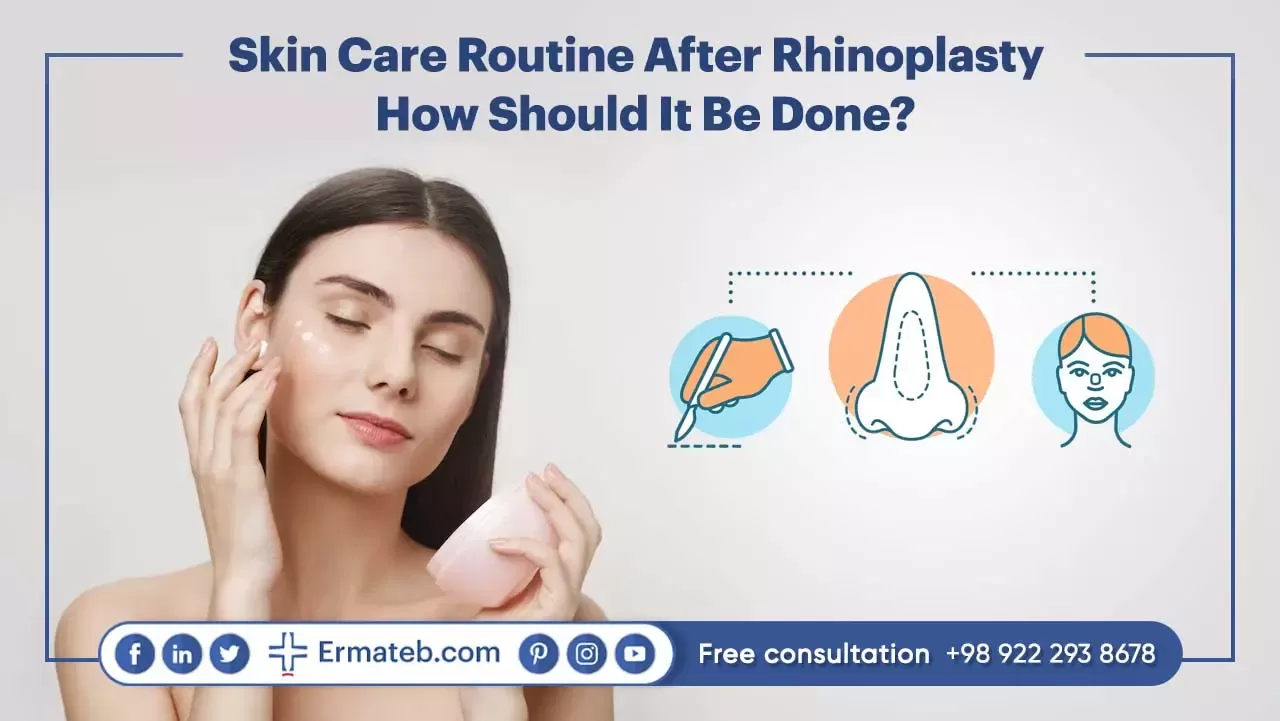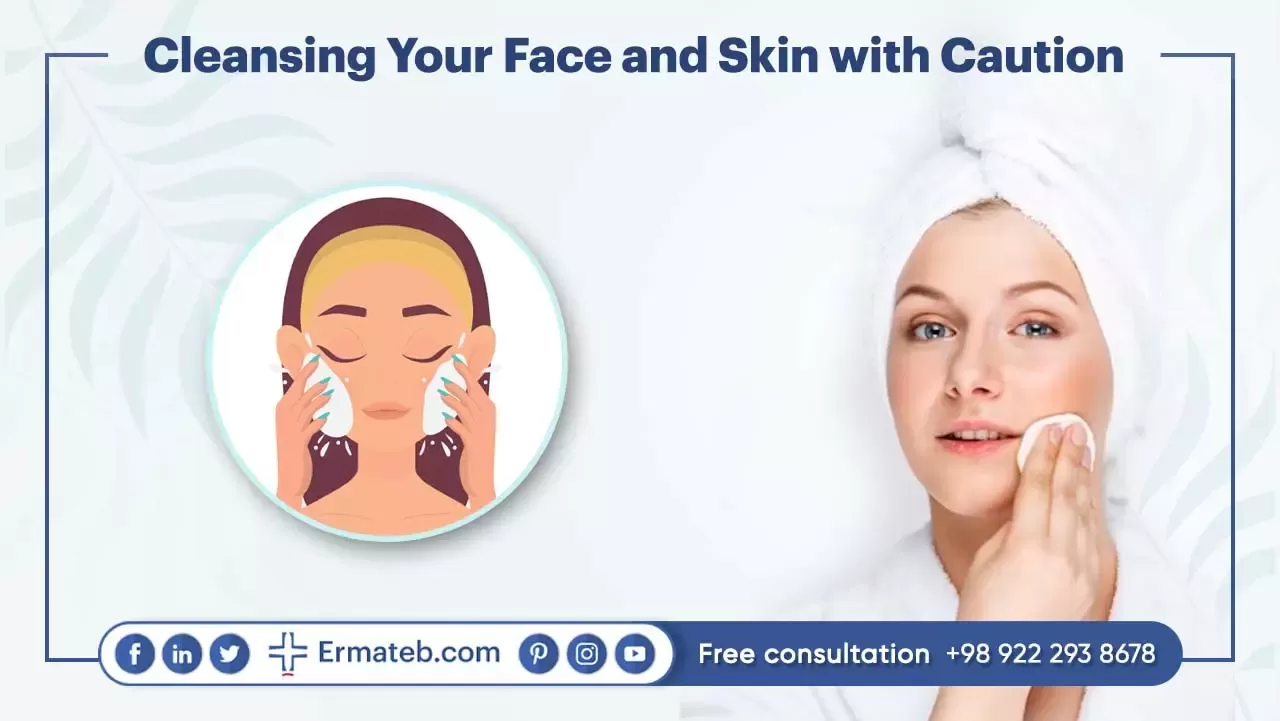
Following rhinoplasty surgery, it's common to focus solely on the well-being of your nose, but it's crucial to recognize that other factors play a role. The final results heavily depend on your commitment to nose care and maintaining a consistent skin care routine after rhinoplasty.

By paying attention to these aspects, you can enhance the overall outcome of the procedure.

After undergoing rhinoplasty, a protective splint will be placed on your nose for approximately one week, accompanied by adhesive tapes functioning as a bandage.
Once the week has passed, your doctor will remove the splint and bandage, revealing your nose which may exhibit slight oiliness and potential skin peeling over time. Some patients may also experience nose pimples arising from sweat accumulation beneath the splint, leading to itching of the skin.
Therefore, it is crucial to approach your skin care routine after rhinoplasty with caution if you desire a swifter healing process and an earlier attainment of your desired final outcome.
To acquire the correct procedure to follow in performing a post-rhinoplasty skincare routine, we recommend adhering to the instructions outlined in this article.
Prior to your rhinoplasty procedure, it is essential to consult with your surgeon or healthcare provider for specific recommendations regarding skin care products after rhinoplasty.
They may provide you with personalized guidelines based on your unique needs and the details of your nose surgery.
While your nose heals after rhinoplasty, it's best to avoid using rough exfoliators, toners, or any products that may irritate or harm the sensitive skin around your nose. Instead, focus on gentle cleansers that won't cause additional irritation but will still effectively clean your skin.
Given the increased sensitivity and redness of your skin following rhinoplasty, it is recommended to utilize gentle and smooth cleansers to manage these symptoms effectively.
For expedited healing of your skin, it is advisable to opt for hypoallergenic and fragrance-free moisturizers. Additionally, using soap-free cleansers and face washing pads can contribute to a faster healing process.
Also, remember to avoid products with active ingredients such as retinoids or alpha hydroxy acids, because it makes your sensitive skin irritated by making it dry.
Furthermore, it's important to steer clear of skincare products that contain active ingredients like retinoids or alpha hydroxy acids. These ingredients can cause dryness and irritation, particularly on sensitive skin after a nose job.
So, along with a fragrance-free moisturizer, it's worth considering a moisturizer specially designed for post-operative care, which avoids the skin to be dried.
These products often contain soothing and hydrating ingredients that can relieve dryness and assist in the healing process.
In addition to the aforementioned products, you might find it beneficial to incorporate the use of wet wipes, micellar water, with moisturizing cotton balls, or soaking the cotton pads in micellar water. These alternatives can be used to gently cleanse and refresh your face.
By being diligent with your skin care routine after rhinoplasty and using gentle, appropriate products, you can support the healing process and optimize the results of your rhinoplasty.

As you may noticed, we always start cleaning our face with starting from nose, and then move on to clean the remaining areas. But since you are wearing nose splint for the first week after nose job, it's crucial to exercise caution and prevent the splint from getting wet.
So, try not to splash water on your face, and instead, moisturize and dampen cotton pads or balls with gentle cleansers or solutions.
Then, you can mildly rub it over and cleanse the skin around your bandage to remove any excess dirt and oil from your face, but remember not to make the bandages wet.
If you prefer, you may also consider using wet wipes, but be mindful not to dampen the bandages and avoid applying excessive pressure.
After the removal of your cast and bandages, you will be greeted by your nose, which may reveal oily skin.
The presence of oiliness can be attributed to the inability to cleanse your nose for a week, resulting in the blockage of pores.
Because now you have your splint removed, you can start washing your face cautiously, and gently pour the water over your face. Again, remember to not put any pressure over your nose.
It is also recommended to use a water-based pH-balanced cleanser, but you may find your nose a little bit sensitive afterwards. Afterall, if you are desired to use moisturizer, try to put a little touch of it on your nose.
Now that your splint has been removed, you can begin washing your face with care, allowing the water to flow gently over your face. However, it is important to avoid applying any pressure to your nose.
In addition, it is worth noting that when selecting a water-based cleanser, choosing one with a balanced pH can further aid in maintaining the skin's natural balance.
While using this type of cleanser, you may still experience some mild sensitivity in your nose immediately after cleansing. If desired, applying a minimal amount of moisturizer to your nose can provide added comfort and hydration to the area.
Remember to be gentle when applying the moisturizer to avoid any unnecessary pressure on the healing skin.
As previously mentioned, in addition to oily skin, it is common to experience some peeling of the skin on your nose after nose surgery. There is no need to be concerned as this is a normal part of the healing process. To address this, you can effectively minimize the peeling by utilizing a gentle cleanser that aids in moisturizing the skin.

After you've thoroughly cleansed your skin, it's crucial to follow up with a moisturizing routine that not only prevents dryness but also aids in the healing process. By employing the right techniques and selecting an appropriate moisturizer, you can achieve optimal results.
To begin, choose a moisturizer that is completely free of any fragrance. Fragrances have the potential to irritate the skin, so opting for a fragrance-free option ensures a gentler experience.
Next, apply the moisturizer onto your skin using your fingertips, taking care to gently rub it in. Avoid exerting excessive pressure, as this could potentially cause your nose to shift or become deviated, particularly considering its sensitivity.
It is also important to remember not to allow your bandages to become wet when applying moisturizers.
Additionally, the choice of moisturizer is crucial, as the ingredients it contains play a significant role in its effectiveness.
Some active elements found in certain moisturizers can actually make your skin more sensitive, so it's essential to choose wisely.
Choose a moisturizer that includes a combination of at least three of the following ingredients:
This natural oil is rich in essential fatty acids and vitamin E, which deeply nourish and hydrate the skin.
Derived from plants, squalane is a lightweight and non-greasy moisturizing ingredient that helps to restore the skin's natural moisture barrier.
A highly effective humectant, glycerin attracts and retains moisture, leaving your skin supple and hydrated.
Hyaluronic acid: Known for its exceptional water-retaining properties, hyaluronic acid helps to replenish moisture levels in the skin, resulting in a plump and youthful appearance.
These lipid molecules are vital for maintaining a healthy skin barrier. They help to lock in moisture, protect against environmental aggressors, and improve overall skin texture.
By selecting a moisturizer that incorporates at least three of these beneficial ingredients, you'll be providing your skin with the nourishment it needs to stay hydrated, balanced, and promote healing. Remember, a proper moisturizing routine is key to maintaining a healthy and radiant complexion.
Furthermore, once you have taken off the nose tapes and bandages, it is highly recommended to incorporate a small amount of a lightweight reparative cream. This proactive step will contribute to expediting the healing process and promoting optimal recovery.
An effective and natural approach to maintain optimal skin hydration is by eating foods rich in vitamins and minerals and ensuring an ample water intake throughout the day. Because as you may be aware, drinking an adequate amount of water aids in keeping your skin free from toxins and impurities.
Therefore, it is essential to establish a well-structured plan to consume 8-10 glasses of water daily. In the event that you struggle to maintain a regular water-drinking routine, you can utilize tools such as planners or smartphone applications that serve as reminders for hydration.
Remember, incorporating sufficient water intake into your daily routine is a natural and essential aspect of skin care routine after rhinoplasty.
By doing so, your skin will remain naturally moisturized, facilitating its self-restoration process and leaving you feeling consistently hydrated and fresh.
Following a rhinoplasty procedure, the skin on and around your nose becomes more sensitive, making it sensitive not only to chemicals but also to the harmful effects of ultraviolet (UV) rays that can penetrate through windows or when you step outside.
To mitigate the risks associated with UV radiation, it is advisable to limit your time spent outdoors. However, if you want to go outside and desire some fresh air, it is essential to apply a non-comedogenic, mineral-based sunscreen daily during this recovery period.
Furthermore, it is crucial to recognize that even when you are at home and in the recovery phase, UV rays can still penetrate through windows and affect your skin. Therefore, it is important to diligently apply a sunscreen with a sun protection factor (SPF) of 30 or 40 every day, even when you are indoors.
Additionally, considering the heightened sensitivity of your skin to UV radiation and strong chemicals after nose surgery, selecting the appropriate sunscreen for your skin care routine after rhinoplasty is paramount.
When choosing a sunscreen, opt for creams with lower SPF factors (around 30 or 40). This is because higher SPF creams can potentially clog your skin pores and impede the healing process.
Remember, the ideal sunscreen should provide protection against UV rays while simultaneously allowing your skin to breathe freely by avoiding pore blockage.
Due to the stretching of the skin around your nose during rhinoplasty, it becomes highly sensitive to sunburn and potential discoloration. Additionally, sun exposure can make your incision and suture marks more visible, and they may or may not fade with time.
To protect your skin, it is advisable to avoid sun exposure, particularly during the initial weeks after surgery. However, if you must go outside, remember to apply sunscreen and wear a hat to adequately shade your nose.
It is also important to note that wearing sunglasses after rhinoplasty is not recommended, because the pressure exerted by the sunglasses on your nose can potentially cause nasal septum depression, and therefore should be avoided.
One week after rhinoplasty surgery, your doctor will remove your splint and bandages from your nose. At this time, you may face with some blackheads and blemishes covering your nose. The reason behind this matter is that the oil gets clogged in the nose’s pores when it’s under the bandages.
But whatever you do, please do not touch or pick at the blackheads in any way!
As your our nose is currently undergoing a delicate healing process and requires gentle care, it is crucial to resist the temptation to pick or squeeze blackheads on your nose following rhinoplasty. Picking at blackheads can disrupt the healing tissues, leading to potential complications and prolonging the recovery time.
For the initial two weeks after your rhinoplasty, it is essential to avoid applying excessive pressure to your nose. Dermatologists strongly advise against using aggressive methods such as harsh scrubs, pore strips, chemical peels, or harsh exfoliants. These treatments can irritate and damage the sensitive post-operative skin, hindering the healing process.
Facial devices like microcurrent or guasha should also be avoided for the first two to four weeks following surgery. These devices can exert unnecessary pressure on your nose, potentially causing discomfort or affecting the delicate structures that are healing.
During the initial healing phase, prioritize hydrating and nourishing your skin with gentle, fragrance-free moisturizers as mentioned. These moisturizers help maintain the skin's moisture barrier and promote healing.
After approximately one month, you can gradually introduce exfoliating treatments to address blackheads. Start by incorporating a salicylic acid-based cleanser to help clear the pores on your nose. As the weeks progress and your skin continues to heal, you can consider adding retinol and mild exfoliants to your routine.
When using exfoliating products, be mindful of the concentration and frequency of use. Start with a lower concentration and use them sparingly to avoid any potential irritation or disruption to the healing process.
It is always advisable to consult with your dermatologist or surgeon before incorporating new products or treatments into your post-rhinoplasty skincare routine.
Remember, patience and gentle care are key during the healing process after rhinoplasty. By following these guidelines and allowing your skin ample time to heal, you can achieve the best possible outcome and maintain the long-term health and appearance of your nose.
After undergoing a nose surgery, you will face with bruising and redness around your nose. Following this, you may be happier with covering your bruises with makeup to not see it regularly. But your doctor may recommend you to not wear any makeup, at least until you remove your splint and bandages.
The reason behind this recommendation is that when you wear makeup, you have to remove it again after some hours. This putting and removing will put much more pressure on your nose and may harm your skin.
Once your bandages are removed, your doctor or surgeon may allow you to put makeup, if your skin is at a good condition and there’s no open wounds on or inside your nose.
For choosing the best product, it is advised to use organic cosmetics which are mineral-based products. Also, to promote proper healing and minimize potential risks, it is important to avoid exfoliating your skin for a minimum of one month after the rhinoplasty procedure.
Chemical peels, ablative laser treatments, and similar applications can pose a risk of infection and scarring if performed too soon. It is essential to allow the top layer of your skin to naturally renew and regenerate before considering such procedures.
When applying creams or foundations to your face, it is crucial to be gentle and avoid applying excessive pressure. The chosen makeup products should have a smooth texture and concealer properties to effectively cover any discoloration or imperfections.
To ensure the undisturbed healing of your incisions, it is advisable to avoid applying makeup directly on them for a specific duration. Therefore, it is crucial to remember that refraining from applying makeup within a 1-centimeter distance from your incisions is highly recommended.
For covering any bruising, redness, or swelling specific to your face, you may opt for concealers with yellow or green undertones. These types of concealers can effectively help minimize the visibility of such discolorations.
Makeup worn during the day should be thoroughly cleaned off at night to maintain skin hygiene and facilitate the healing process. Keeping your skin clean is of utmost importance during the recovery phase.
When washing your face, remember to choose a soap-free cleanser that is gentle and suitable for your skin type to avoid any potential irritation.
Read More: Make Up After Rhinoplasty
It is common for individuals to experience itchiness on their skin following rhinoplasty surgery. This can be attributed to the increased sensitivity of the skin and the presence of stitches and sutures. However, there is no need to worry as this itching sensation typically subsides within a few days.
If you find it difficult to cope with the itchiness, it is important to avoid scratching the area. Instead, gently rub the skin and the surrounding area of the incisions without applying any pressure. This can provide temporary relief without compromising the healing process.
To alleviate itching, you can use a saline intranasal spray and apply a gentle moisturizer on the skin once the bandages have been removed.
Additionally, applying a cold compress near the sutures can offer soothing relief. However, it is crucial to avoid placing the cold compress directly on your nose to prevent any potential discomfort or damage to the healing incisions.

It is generally recommended to wait until the initial healing phase is complete before resuming your regular facial routine after rhinoplasty. This is to ensure that the surgical site has properly healed and any potential sensitivity or swelling has subsided.
It is important to consult with your surgeon for personalized advice regarding the appropriate timing to resume your facial routine. They will be able to assess your specific case and provide guidance based on your individual healing progress. Following their instructions is crucial to ensure a safe and successful recovery.
Most doctors and surgeons will recommend to wait for a minimum of 3-4 weeks after undergoing rhinoplasty before initiating any facial routine. This timeframe allows the skin and nose to heal effectively. If your nose is still sensitive, it is advisable to postpone your facial routine until your skin has fully healed.
It is important to exercise caution and prioritize the complete recovery of your nose before considering more intensive facial treatments like microdermabrasion, chemical peels, or facial laser procedures.
Waiting until you have achieved a full recovery will help ensure the best outcomes and minimize any potential risks or complications.